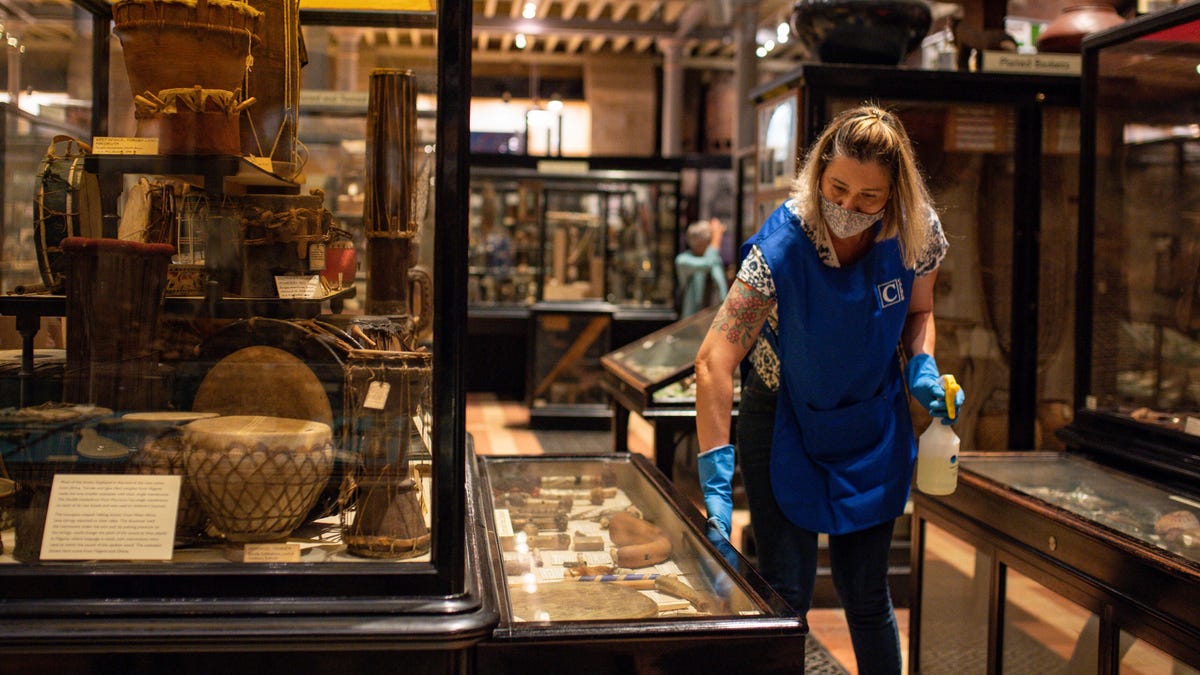Coronavirus may linger on surfaces longer than expected, scientists say
The virus that causes COVID-19 remains on bank notes, glass and vinyl for 28 days under laboratory conditions.

How often coronavirus transmission occurs from touching contaminated surfaces is yet to be fully determind.
Coronavirus transmission is believed to occur predominantly via prolonged and close person-to-person contact. That's why masking up, maintaining social distancing and washing hands are all critical for preventing infection. But since the early days of the pandemic scientists have also sought to understand how SARS-CoV-2, the virus that causes COVID-19, may survive and spread via contaminated surfaces.
New research conducted by scientists at the CSIRO, Australia's national science agency, suggests SARS-CoV-2 can linger on non-porous surfaces for longer than expected. The study, published in the Virology Journal on Monday, was conducted under controlled laboratory conditions and in the dark, but it reveals the hardiness of SARS-CoV-2 when the conditions are just right.
"Our results show that SARS-CoV-2 can remain infectious on surfaces for long periods of time, reinforcing the need for good practices such as regular handwashing and cleaning surfaces," said Debbie Eagles, deputy director of the the Australian Centre for Disease Preparedness (ACDP).
The team isolated the virus and created a solution described as "an artificial mucus" which contains viral particles at a similar concentration to those seen in infected patients. They placed droplets of the mixture onto a range of different surfaces, including plastic and paper bank notes, stainless steel, cotton and vinyl. They also put glass, like that used in ATMs, check-outs and mobile phones , to the test.
The team's goal was to discover if the virus remained infectious on surfaces after being exposed to temperatures of 20, 30 and 40 degrees Celsius (68, 86 and 104 degrees Fahrenheit). They sampled the materials at five different time points, ranging from one hour to 28 days.
Their results demonstrated the virus can remain viable for at least 28 days at 20 degrees Celsius -- similar to reported figures for the original SARS virus, but longer than previously published data on SARS-CoV-2. An important finding, the researchers write, is the persistence on glass and the capability for SARS-CoV-2 to be picked up from something like a smartphone screen.
However, the team note the study was performed under controlled conditions, which may improve the survival time of the virus. Increasing the temperature decreased the ability for the virus to survive. At 40 degrees Celsius, SARS-CoV-2 was no longer viable within 48 hours. In the opposite direction, at even cooler temperatures, the virus may have an even better chance of survival.
"The research may also help to explain the apparent persistence and spread of SARS-CoV-2 in cool environments with high lipid or protein contamination, such as meat processing facilities," explained Trevor Drew, director of ACDP, which conducted the studies. Australia has seen several instances of COVID-19 outbreaks at meat packing facilities.
The study adds to a growing body of evidence about SARS-CoV-2's resilience to the elements, but doesn't settle the debate of transmission via infected surfaces.
"While the precise role of surface transmission, the degree of surface contact and the amount of virus required for infection is yet to be determined," Eagles noted. "Establishing how long this virus remains viable on surfaces is critical for developing risk mitigation strategies in high contact areas."
The argument for "fomite transmission" -- infection via contaminated surfaces -- has appeared numerous times over the course of the pandemic, stretching back to March. Several studies have shown the coronavirus can persist on a variety of surfaces but it remains unclear how relevant this is outside of the lab. In July, a comment published in prestigious medical journal The Lancet, suggested the risk of transmission via fomites was "exaggerated" because studies are mostly performed in the lab which doesn't accurately replicate real-world scenarios.
The CDC notes "COVID-19 spreads less commonly through contact with contaminated surfaces," and reiterates the main mechanisms of infection are via droplets and aerosols from infected individuals.
While there may be more impetus to wipe down your smartphone screen with disinfectant, the chief health advice for the majority of the public doesn't change: Mask up, social distance and wash your hands.
Update Oct. 11: headline changed to reflect quotes, clarified Eagles quote.

